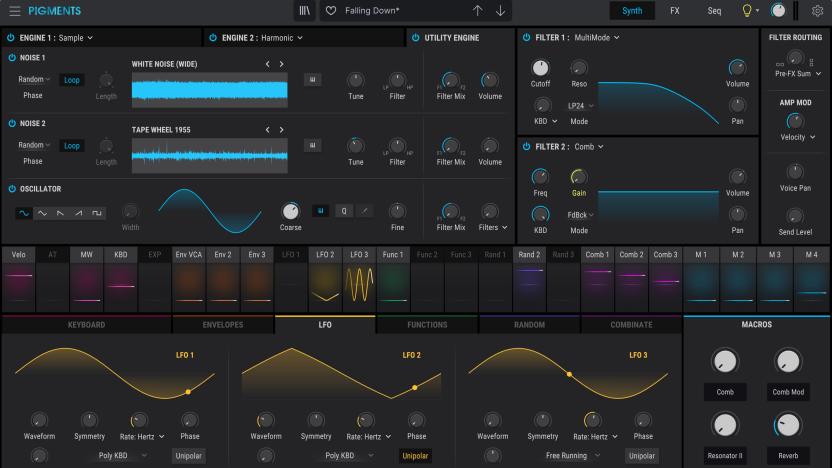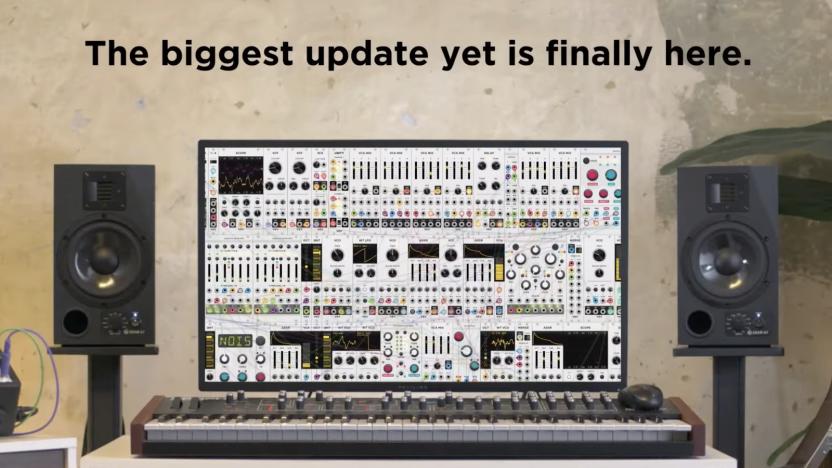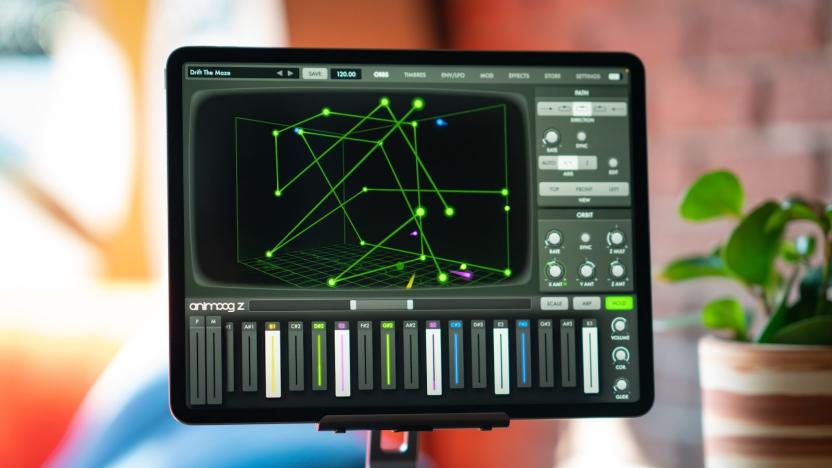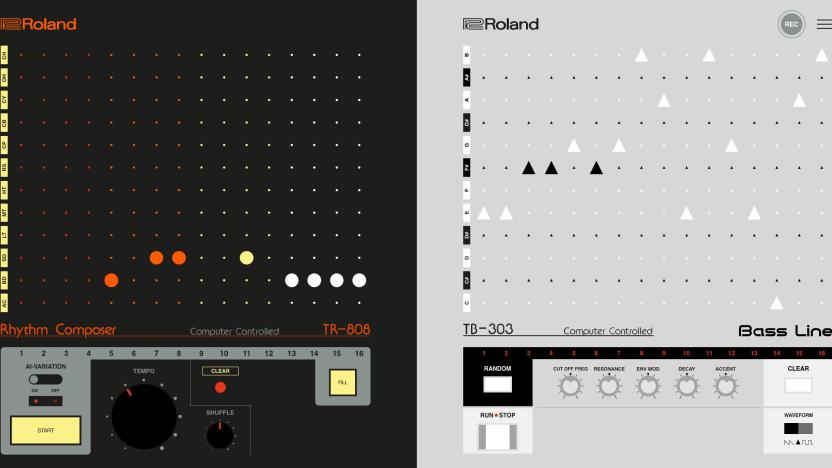synthesizers
Latest

Arturia’s free Pigments 3.5 upgrade adds M1 support and a distortion module
Arturia's Pigments 3.5 adds a versatile new distortion effect and Apple M1 compatibility.

Virtual modular synth VCV Rack 2 is now available
VCV Rack 2's paid tier lets you use it within a digital audio workstation.

Animoog Z ushers the landmark iOS synth into the modern age
Animoog Z is a worthy successor to Moog's groundbreaking iOS instrument.

Roland brings its classic TR-808 and TB-303 synths to your browser
Roland’s vintage TR-808 drum machine or TB-303 bass synthesizers helped define electronica in the ‘80s, but nowadays they’re nearly impossible to find. Luckily, you can jam with both instruments for free online, thanks to a new site called 808303.studio created by Roland, musician Yuri Suzuki and the London Design Museum.

Ableton teaches synthesizer basics from the comfort of a browser
From creating grungy music with drone motors to perfecting DIY digital setups and recreating 60-year-old music machines, there are plenty of cool things you can do with synthesizers. But synths can be hard to understand, and if you're unfamiliar with them, you might feel a little left out. Ableton wants to change that. The company's new Learning Synths interactive website offers step-by-step synthesizer lessons, followed by a "playground," where you can put your new skills to the test.

Korg's fun-to-use Electribe sequencers pack big features into a tiny frame
Creating music has become incredibly easy thanks to computers and low-cost (sometimes free) software. For example: Using just a MacBook and GarageBand, aspiring rock gods can pump out the jams without hunting down musicians and booking studio time. But when you want to play live, pushing a button on computer just isn't very exciting to watch. MPC and MPS (Music Production Controller and Music Production Station) systems, on the other hand, offer access to your finely crafted songs with the option to build a beat from scratch on the fly without dragging a laptop onstage. That's where Korg's two updated Electribes come in.

Teenage Engineering's new pocket synths mine the sounds of the '80s
Until last year, buying a Teenage Engineering synthesizer meant spending hundreds of dollars. But the Pocket Operator series that debuted at NAMM in 2015 changed that equation by putting the company's sound in your pocket for only $59. Sure, they're not nearly as capable as the company's flagship OP-1, but that'll set you back $850. For less than a quarter of that, you could buy all three Pocket Operator synths, chain them together and start making music.

Trap Studio helps you create your own music on any iOS device
Trap Studio (US$2.99) is a music creation app that includes more than 350 samples created by Prime Loops. Along with that, the app features dual Oxford Synthesizer Company (OSC) Synthesizers, and you can import samples and apply many effects to them to create a unique sound. Sounds from Prime Loops have been featured in chart-topping tracks from artists such as Skrillex, Lady Gaga, Beyonce, and Grammy Award winning producers including RedOne & DJ Frank E. Samples are categorized as Drums, Bass, Synth and SFX, and you can apply effects like distortion, echo, flanger and more to your samples as well. There is a virtual keyboard so you can enter your own compositions. Use your iOS device built-in microphone to add vocals or other audio, and then saved tracks can be uploaded to SoundCloud or shared via email, Facebook, Twitter, Tumblr and Foursquare. Files are saved in uncompressed .wav format and Trap Studio includes complete documentation. I tried creating some background tracks and it was pretty easy to do even without looking at the help files. You can overlay tracks, of course, and edit their in and out time. I was able to save a project and come back to it later for additional work without any glitches. Trap music originated in the early 2000s from Southern hip hop. More recently, music producers have re-energized the genre by putting elements of Trap into their music. There is an amazing amount of useful technology crammed into Trap Studio. It's a testament to how far iOS has come and how useful iOS devices are as solid content creation platforms. Putting a Digital Audio Workstation on a phone would have have been unthinkable just a few years ago. Trap Studio is reasonably priced, and was solid in my testing. My music skills never got much beyond playing the trumpet in high school and college band and orchestra, but Trap Studio is easy to use and powerful. For those who need to create, Trap Studio is an inexpensive purchase. In the hands of a good musician, it's a powerful tool. The Trap Studio website has more info and some demo videos and songs. Trap Studio requires iOS 7 or later, and it is optimized for the iPhone 5.

Bananaphone touch synthesizer replaces ring ring rings with chiptunes (video)
If you're tired of bananaphones that just make calls, the crew at Gadget Gangster now has a homebrew project to use them for musical escapades. A custom-coded (and appropriately named) Adafruit Propeller board turns a bunch of bananas into the Bananaphone TouchSynth, a synthesizer using the same capacitive touch principles that let a MaKey MaKey turn anything into a controller. The project as it's built won't be rocking stadium-sized crowds anytime soon -- not with those beeps and that lone speaker -- but there's nothing stopping it from scaling up to bigger sounds. Just remember that your fresh beats will turn very brown within a few days.

'Kraftwerk Who?' Pioneering '50s Synthesizer unearthed in French Barn
So there Dr. Mick Grierson was, wandering around a French barn, minding his own business when all of a sudden he happened upon an antique: one of the earliest modern synthesizers. Grierson, a professor at Goldsmiths University in London did what any expert in the field of electronic music would do, and whisked it back to the motherland for restoration. The Oram "Oramics" Synthesiser (sic) was built by Daphne Oram in 1957, a year before she co-founded the BBC Radiophonic Workshop to research and develop electronic music. Political wrangling within the corporation forced her to leave in 1959, and she retreated to a farm in nearby Kent to tinker with her invention. After her departure, the Workshop shot to fame for creating the original electronic theme to Doctor Who. In order to create music on the Oram, a composer painted waveforms directly onto 35mm film strips which were fed into the machine. Inside, photo-electronic cells read the light pattern and interpreted it as sound. Check out the video to see the arrival of the machinery back into England where it'll be on display all the way through December 2012. If you're really interested you can tap Dr Grierson's homebrewed Oramics iPhone app (linked below for your downloading pleasure) to create your own futuristic theme songs, '57-style.

The Parker Steam Synthesizer runs on steam, sounds like a theramin, Bjork wants
If synth rock was meant to go hand-in-hand with fantastic steampunk universes (and we really can't see why it wasn't), instruments would look something like the thing you see here. This is the Parker Steam Synthesizer, a steam-powered music synth that runs on water and some coal. Designer Lorin Edwin Parker controls steam pressure with a ball valve which activates a dynamo. The dynamo is a magnet motor attached to a flywheel that creates an alternating magnetic field which is then turned into electricity by an inductive pickup. That pickup is finally plugged into an amp and you have some trippy electro from a device that could have been around years ago. He says it will run for about 20 minutes on one tank of water, which, in our estimation, is just long enough for Bjork to hear it and add to her band's already-insane inventory. By the way, the Read link includes a .mov file so you can see this thing in action.[Via MusicRadar]








